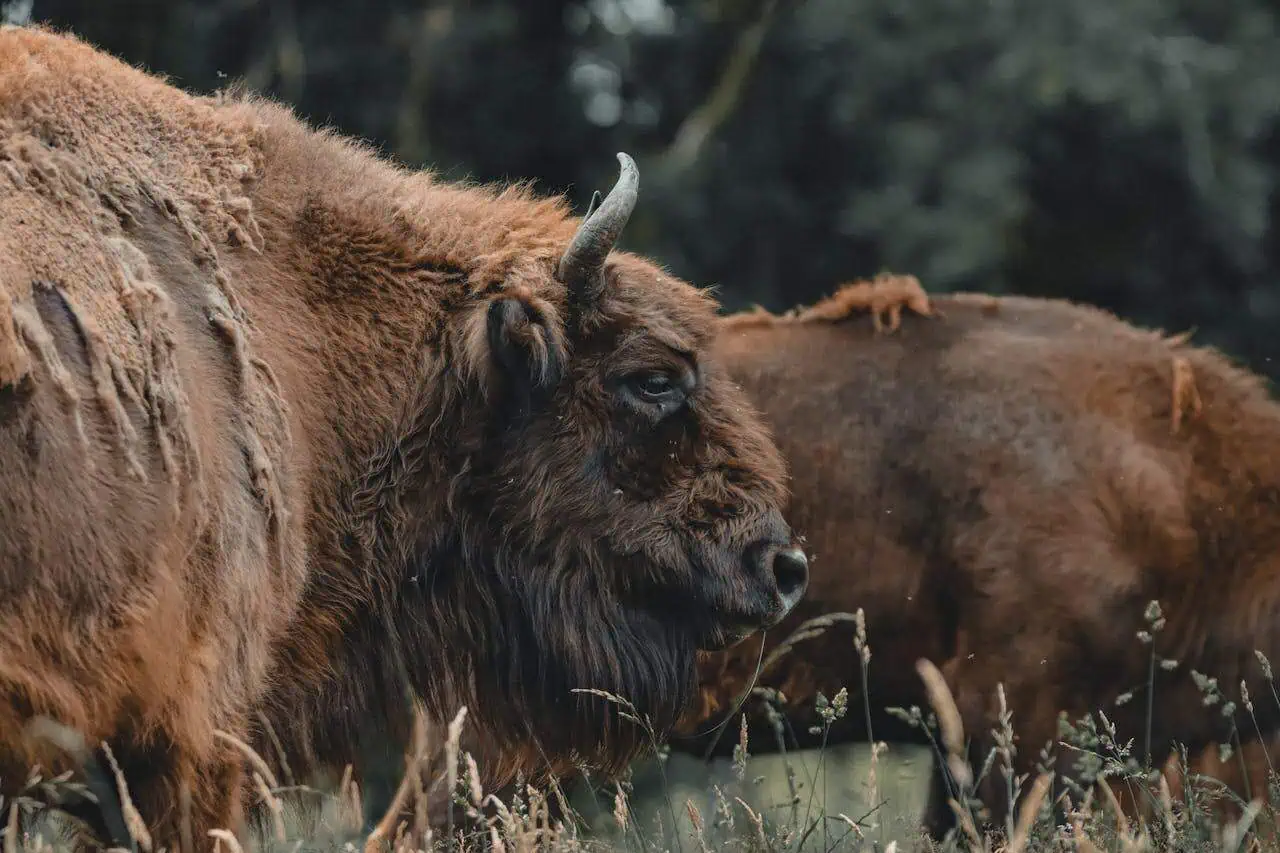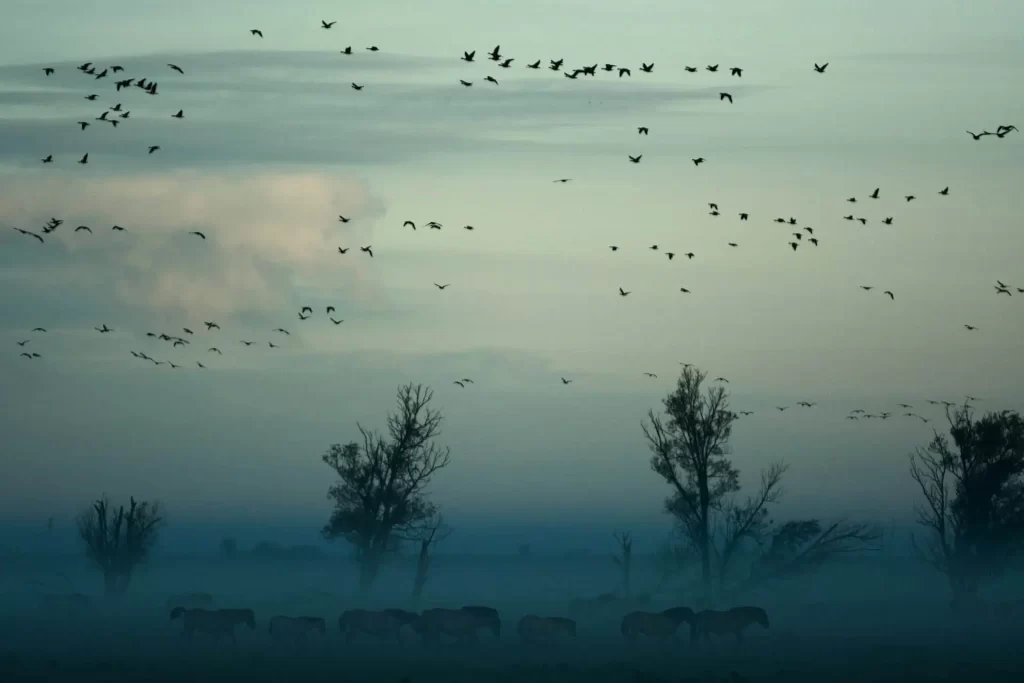Share:
Rewilding European Bison in Spain: Native Species vs. Ecological Substitutes

The European bison, once on the verge of extinction, now roams numerous protected areas across Europe, standing as a symbol of conservation success. From a near-collapse to a thriving population, this iconic species has captured the attention of conservationists across Europe. However, there is an ongoing debate in Spain: does the European bison belong to the Iberian Peninsula?
Proponents of the rewilding effort argue that historical evidence, including ancient cave paintings from Spain’s Altamira and El Castillo caves, suggests that bison once inhabited the region. They view the bison as a potential keystone species capable of restoring ecological balance to degraded landscapes, particularly in rural areas where human presence has diminished. Advocates believe that reintroducing this species could help revitalize ecosystems that have suffered from overgrazing and land abandonment.
But a recent peer-reviewed article published in Conservation Science and Practice raises serious doubts about the ecological, legal, and historical basis of these efforts. The authors argue that introducing European bison into Spain may be not only scientifically unjustified, but also ecologically risky and potentially illegal under current conservation laws.
At the heart of the debate lies a deceptively simple question: Are European bison native to Spain?
Echoes from the Pleistocene
At first glance, the case seems compelling. Ancient bison-like figures dominate Spain’s prehistoric art — some drawn with such detail and motion they rival the expressive power of modern sketches. To many, this is compelling visual evidence that bison once thundered across Iberian valleys.
But scientific scrutiny paints a more complicated picture. The authors of the article highlight a key point often overlooked in popular narratives: The bison species represented in those cave paintings is almost certainly Bison priscus, the extinct steppe bison, not the modern Bison bonasus — the European bison.
The steppe bison was part of a now-vanished ecosystem known as the “mammoth steppe” — a vast, treeless, cold-adapted grassland that once stretched from Western Europe to North America. When this ecosystem disappeared at the end of the last Ice Age, so too did the steppe bison. The European bison evolved later and adapted to a more forested, temperate environment — and crucially, there is no strong paleontological evidence that it ever lived in Spain.
In other words, even if bison-like creatures once walked Iberian soil, they were not the same species that conservationists seek to introduce today.
Steppe bison in mountain areas
While the term “steppe” typically refers to vast, treeless grasslands, scientific research indicates that steppe bison inhabited a range of environments, including mountainous regions like those in northern Spain.
Fossil evidence supports that steppe bison thrived in these regions. For instance, the Kiputz IX site in the Basque Country has yielded well-preserved remains of steppe bison, including a nearly complete skull, indicating their presence in the southern Pyrenees. The skull from Kiputz IX aligns with the characteristics of the extinct subspecies Bison priscus mediator.
The cave paintings in Altamira and El Castillo, located in the mountainous terrains of northern Spain, prominently feature bison imagery. These artistic representations align with the fossil record, suggesting that steppe bison were indeed part of the local fauna during the periods these caves were inhabited. The presence of steppe bison in these areas indicates their adaptability to different environments within the broader “Mammoth Steppe” biome.
Bison priscus mediator was a later subspecies of steppe bison that emerged towards the end of the Pleistocene, exhibiting adaptations to changing environmental conditions. As the Ice Age drew to a close and the climate began to warm, the ecosystems of the northern hemisphere started shifting from cold, open steppe landscapes to more varied and forested environments. Bison priscus mediator likely adapted to these new conditions by modifying its diet and habitat preferences, making it more suited to a broader range of environments, including areas with more woodland cover. This subspecies represents a transitional phase in the evolutionary history of the steppe bison, bridging the gap between the cold-adapted forms of the earlier Pleistocene and the more temperate conditions that followed, which may have contributed to its eventual survival and spread across a wider area of Europe.
Rewilding or Reinventing?
The term “rewilding” evokes powerful imagery — untamed landscapes, ecological restoration, and charismatic megafauna reclaiming lost territory. But when does rewilding cross the line into ecological invention?
The article warns that introducing European bison to Spain would be a “non-native species introduction” — something that contradicts core principles of conservation biology. Without clear historical evidence of the species’ presence, such an action risks disturbing delicate ecosystems rather than restoring them.
Spain’s landscapes, particularly in regions like Andalucia and Extremadura where bison have already been introduced in private initiatives for ecotourism purposes, are significantly different from the mixed forests and meadows of Eastern Europe. The climate is drier, summers are hotter, and the vegetation is not the same. These differences raise questions about whether the bison could thrive — or whether they would overgraze sensitive habitats, compete with native herbivores, or suffer from poor health and condition.
Moreover, the authors point out a critical oversight in many of the pilot projects: There is often little or no scientific monitoring, no published environmental impact assessments, and no adaptive management frameworks in place. In essence, the releases are happening in a data vacuum.
Substitute species
Bison bonasus, or the European bison, could serve as a potential substitute species for the extinct Bison priscus in certain ecosystems. As a close relative, the European bison shares many ecological characteristics with Bison priscus, particularly its role as a large herbivore that shapes landscapes through grazing. Reintroducing Bison bonasus into areas where Bison priscus once roamed could help restore key ecological functions that have been lost with the extinction of the latter. The European bison is known for its ability to graze on a wide variety of vegetation, which could contribute to the control of overgrown or invasive plant species, promote biodiversity, and create open habitats that benefit other wildlife species.
Although not a direct replacement for Bison priscus, Bison bonasus can still fulfill many of the same ecological niches in modern European ecosystems. Bison bonasus’s grazing behavior influences the structure and composition of plant communities, promoting habitat diversity in woodlands, grasslands, and wetlands. Its presence can encourage the growth of specific plant species while suppressing others, which in turn supports the regeneration of certain ecosystems.
Ecological boundaries
In areas like the southern parts of Europe or even parts of Spain, where Bison priscus once roamed, the European bison could help in the restoration of a more natural balance by reintroducing this large herbivore to forested and grassland areas, even though it is not native to the Iberian Peninsula.
The concept of Bison bonasus as a substitute species is part of a broader ecological restoration strategy aimed at compensating for species extinctions, helping to restore lost ecological functions and balance. By focusing on the ecological roles that Bison priscus played, Bison bonasus could effectively take on these responsibilities.
This approach is seen in various rewilding projects across Europe, where, for example, semi-wild cattle take on the role of the extinct aurochs. While Bison bonasus may not be a perfect match in terms of genetic lineage, its similar ecological impact and ability to thrive in temperate habitats make it a viable candidate for fulfilling the lost ecological roles of the extinct steppe bison.
However, the hotter and drier climate in the southernmost parts of the Iberian Peninsula, particularly in the southeast, presents significant challenges for the European bison, a species more suited to the milder temperatures and higher rainfall typical of northern and central Europe.
Reintroducing European bison in southern Spain is unlikely to be viable from both a species and ecological perspective, as the region’s arid conditions, limited vegetation, and lack of suitable habitats would not support the species’ survival or its role in maintaining ecological balance, which depend on cooler, more temperate environments.
Conservation Priorities: The Bigger Picture
At its core, the debate over European bison in Spain is about more than just one species. It’s about how we define conservation success and the kinds of stories we tell about nature.
The authors of the study urge caution and reflection. Conservation resources are finite. Rather than investing in questionable introductions, they suggest focusing on the protection and recovery of native Spanish species and habitats — from the Iberian lynx and Spanish imperial eagle to the fragile cork oak forests and high mountain meadows.
They also emphasize that rewilding should not become a license to “import” charismatic animals without clear ecological fit. If poorly planned, such efforts risk discrediting the broader rewilding movement, which has the potential to play a meaningful role in restoring degraded ecosystems — when done right.
The European bison’s journey from near-extinction to cautious recovery is a powerful conservation story. But the desire to expand its range must be balanced with ecological realism and respect for historical evidence. The authors of this recent study offer an important reminder: Not every attractive idea is a good one — especially when nature’s balance hangs in the hands of human ambition.
More information:
Rewilding through inappropriate species introduction: The case of European bison in Spain






